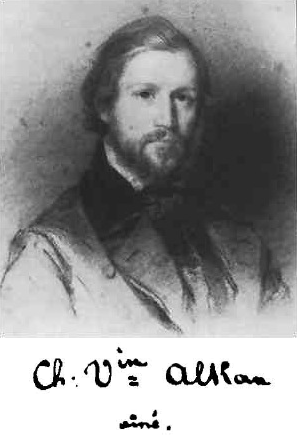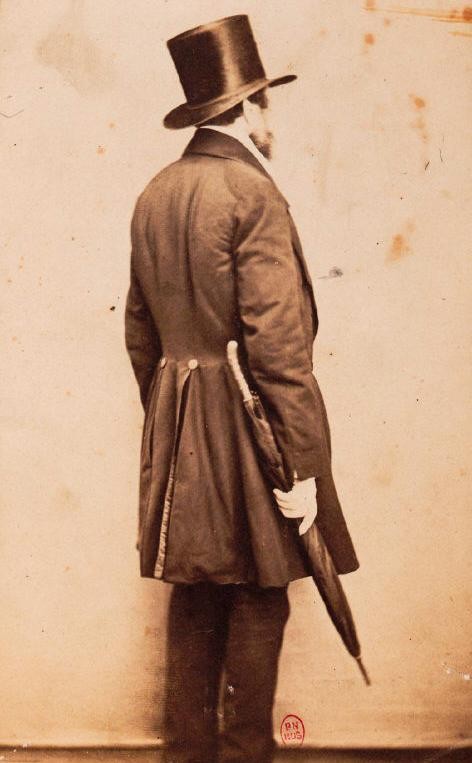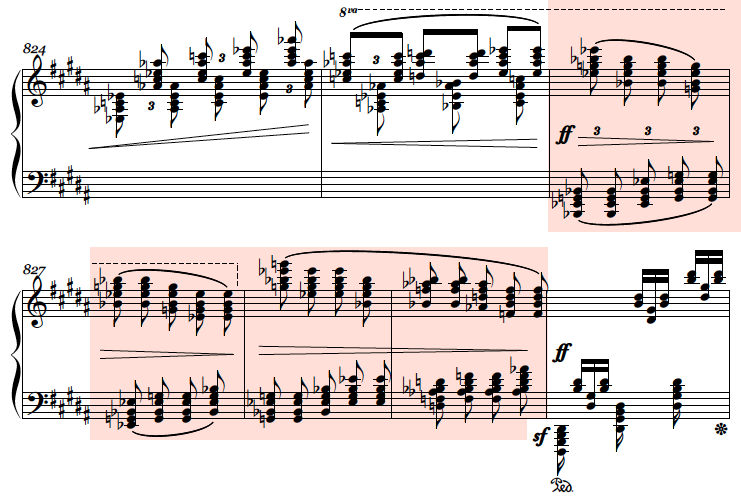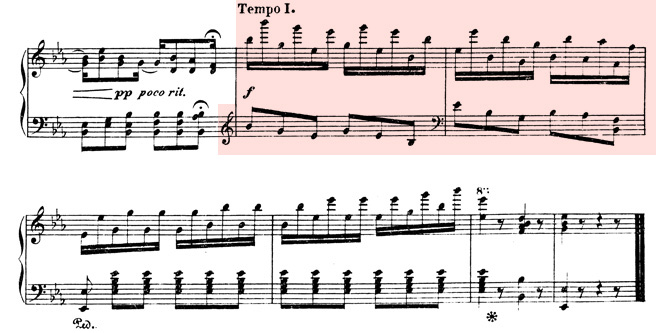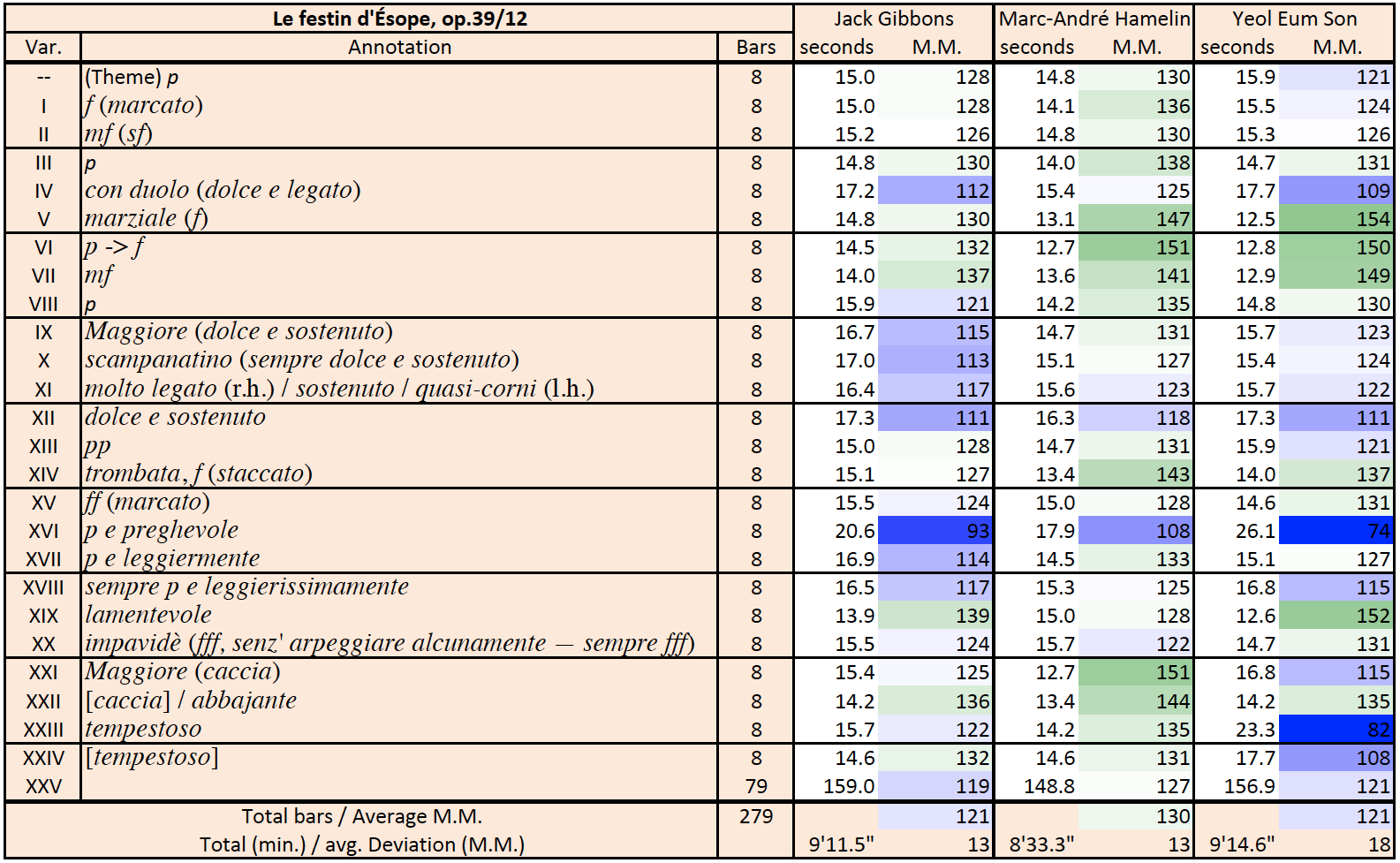Charles-Valentin Alkan
12 Études dans tous les tons mineurs, op.39 & Other Piano Works
Media Review / Comparison
2014-03-04 — Original posting (on Blogger)
2014-11-11 — Re-posting as is (WordPress)
2016-07-18 — Brushed up for better readability
2018-03-14 — Minor amendments, additional links
2019-08-27 — Added outline, clarified structure, new addendum
Table of Contents
- Alkan, The Composer
- Alkan’s op.39 in My Collection
- The CDs
- The Reception of Alkan’s Music
- Performances of the “12 Études dans tous les tons mineurs”, op.39
- The Études in the Above Recordings of op.39 — Overview
- The Études in op.39 —Performance Comments
- Symphonie pour piano solo
- Concerto pour piano solo
- Other Compositions by Alkan on the Above CDs:
- Souvenirs ” Trois morceaux dans le genre pathétique “, op.15
- Nocturne in B major, op.22
- Alleluia , op.25
- From the Préludes , op.31
- Grande Sonate , op.33, ” Les quatre âges “
- From the 12 Études dans tous les tons majeurs , op.35
- From the Premier Recueil de Chants , op.38a
- ” Salut, cendre de pauvre! “, op.45
- Sonatine , op.61
- From the 48 Esquisses , op.63
- From the Troisième recueil de chants , op.65
- From ” Les mois “, op.74
Alkan, The Composer
This posting briefly summarizes my encounters with a not-so-well known composer, Charles-Valentin Alkan (1813 – 1888), whose 200th birthday was on November 30th, last year. Alkan was an interesting, though somewhat obscure figure: the commenter in the booklet to the last CD below, Jeremy Nicholas, claims “He was one of the greatest composer-pianists in history. He had a voice as original and individual as Chopin and Liszt, and a keyboard technique that even Liszt admitted was the greatest he had even known.” (The information in following biographical notes is adapted from the same text / booklet.)
Alkan was a contemporary, friend and colleague of Chopin and Liszt — he was born in Paris and temporarily lived in the neighborhood of people such as Kalkbrenner, Dumas (fils), Frédéric Chopin and George Sand; he had considerable success initially, enjoying a reputation as one of the leading piano virtuosos (along with Chopin and Liszt) — but a series of (personal / private) events led him to retract from public life from 1838 to 1844; he did eventually return to the stage — for a mere three concerts.
Retracting from the Public
In 1848 he did not get the expected post at the conservatoire, and after a last chamber concert in 1849 he did not play again in public for nearly 25 years and mostly refused contacts with people or the public altogether. Jeremy Nicholas writes: “Alkan died on 29 March 1888. The cause of death was one of the most improbable in musical history. He was allegedly crushed to death by a bookcase that toppled over as he reached up to retrieve a book in his Paris home.
Apart from his immediate family, there were just four mourners at his funeral.” and “When he died in 1888, an obituary in Le Ménestrel opened: ‘Charles-Valentin Alkan vient de mourir. Il a fallu qu’il meure pour qu’on soupçonne son existence. (…) un artiste infiniment supérieur aux milliers de ses contemporains plus célèbres et plus louangés'”. Translation: Charles-Valentin Alkan has just died. It was necessary for him to die in order (for people) to suspect his existence. (…) an artist infinitely superior to the thousands of his more celebrated and praised contemporaries.
Legend?
The story with the bookcase causing his death was later dismissed as a legend (he apparently died after fainting and falling in his kitchen). Jack Gibbons states that also the above obituary quote is almost certainly a fake / made up, and that it never appeared in Le Ménéstrel; even if it were a fake, it still shows how some commenters viewed Alkan early in the last century, and how legends are instilled into the public opinion.
In line with Alkan’s self-imposed isolation, there are just two photographs of the composer-artist!
Alkan’s op.39 in My Collection
I have had 3 CDs with works by Alkan for a while, played by Marc-André Hamelin. Hamelin is one of my favorite pianists for highly virtuosic, romantic / late romantic piano repertoire, with composers such as Godowsky (see the Listening Diary 2013-06-28), Liszt, Medtner, Reger and Scriabin (see the Listening Diary 2013-09-30) — for a more detailed list see again the Listening Diary 2013-06-28.
Marc-André Hamelin
The three Alkan CDs with Hamelin (see below for details) featured parts of the “12 Études dans tous les tons mineurs”, op.39 (12 studies in all minor keys) — a monster set of compositions (by far surpassing the scope of an ordinary Étude!), consisting of
- Comme le vent (Prestissimamente, a minor) — ca. 4.5′
- En rhythme molossique (Risoluto, D minor) — ca. 8′
- Scherzo diabolico (Prestissimo, G minor) — ca. 4.5′
- Symphonie pour piano solo: Allegro (Allegro moderato, C minor) — ca. 10.5′
- Symphonie pour piano solo: Marche funèbre (Andantino, F minor) — ca. 6.5′
- Symphonie pour piano solo: Menuet (Tempo di minuetto, B minor) — ca. 5.5′
- Symphonie pour piano solo: Finale (Presto, E♭ minor) — ca. 4.5′
- Concerto pour piano solo: Allegro assai (G♯ minor) — ca. 29′
- Concerto pour piano solo: Adagio (C♯ minor) — ca. 12′
- Concerto pour piano solo: Allegretto alla barbaresca (F♯ minor) — ca. 10′
- Ouverture (Maestoso – Lentement – Allegro – Allegro vivace, B minor) — ca. 15′
- Le festin d’Ésope (Allegretto senza licenza quantunque, E minor) — ca. 9′
So far, Marc-André Hamelin has recorded the “Symphonie pour piano solo” (Études #4 – #7, recorded 2000), the “Concerto pour piano solo” (Études #8 -#10, recorded 2007), and the last piece, “Le festin d’Ésope” (Étude #12, recorded 1994).
Jack Gibbons
Another pianist, Jack Gibbons, has recorded the entire set of Études, op.39, back in 1995 — he is proud to be one of very few pianists who have performed the entire cycle (that’s 2 solid hours of very demanding, virtuosic piano music, not including any breaks!) in concert (he did that in the mid-90s, and again last year). I could not resist adding Jack Gibbons’ recording, as this was a chance to listen to op.39 in its entirety:
The CDs
Alkan: 12 Etudes op.39 — Jack Gibbons
Charles-Valentin Alkan: Nocturne in B major, op.22; 3 Préludes from op.31; Études, op.35/5; Chant, op.38/1; 12 Études, op.39; “Les mois”, Suite I, “Gros temps”, op.74/2; Chant, op.85/6
ASV CD DCS 227 (2 CDs, stereo); ℗ 1995 / © 2005
Booklet: 7 pp., English

Alkan: Grande Sonate op.33, Le festin d’Ésope op.39/12, etc. — Marc-André Hamelin
Charles-Valentin Alkan: Grande Sonate “Les quatre âges”, op.33; Sonatine, op.61; Barcarolle, op.65/6; “Le festin d’Ésope“, op.39/12
Hyperion CDA66794 (CD, stereo); ℗ / © 1995
Booklet: 16 pp., e/f/d

Alkan: Symphony for solo piano, op.39/4-7, etc. — Marc-André Hamelin
Charles-Valentin Alkan: “Souvenirs: Trois morceaux dans le genre pathétique“, op.15; “Alleluia“, op.25; Symphony for solo piano, op.39/4-7; “Salut, cendre du pauvre!“, op.45; “Super flumina Babylonis“, op.52
Marc-André Hamelin
Hyperion CDA67218 (CD, stereo); ℗ / © 2001
Booklet: 20 pp., e/f/d

Alkan: Concerto for solo piano, op.39/8-10, etc. — Marc-André Hamelin
Charles-Valentin Alkan: Concerto for solo piano, op.39/8-10; Troisième receuil de chants, op.65
Hyperion CDA67569 (CD, stereo); ℗ / © 2007
Booklet: 16 pp., e/f/d

The Reception of Alkan’s Music
Before I start discussing the above recordings, let me add another piece from the booklet to the last CD above, by Jeremy Nicholas: “Much of Alkan’s music is of surpassing difficulty, taking it way beyond the realm of the amateur and playable only by virtuosi with transcendent techniques.” I’m sure this is a major reason why Alkan’s music is so little known: it was published only sporadically — why should a publisher issue scores that very few people are able to play / willing to tackle? Primarily, Alkan’s scores are so dense, packed with technical difficulties, such that some listeners might have problems following the score, and for the artist even just reading and memorizing the score must be hard work.
However, an artist needs substantial technical “reserves” on top of the level required to mastering the score and playing all notes in the appropriate tempo, for the music to make sense to the listener; in particular, the melody is often buried in a heap of rapid accompaniment, and it often is a challenge to play this music such that the listener can discriminate between melody and accompaniment. In addition, the dimension of some of these pieces is monstrous — the longest Étude from op.39 lasts almost half an hour, so the sheer physical demand in performing this music is enormous.
Challenges for the Listener
Another reason why this music isn’t played more often may be on the listener’s side: Alkan’s music is in his own, personal style, distinctly different from Chopin and Liszt. He was sometimes compared to Berlioz, a composer that he didn’t really like. He didn’t try following or fitting into any school.
The scope of expressions in his music may not be quite as wide as with Chopin’s or Liszt’s (some may find that it takes some effort to get used to this music). Also, the length of his pieces (let alone a performance of an entire series of his compositions) may scare off some listeners. On top of that, if the artist isn’t really on top of the technical demands imposed by these compositions (see above), this music may degenerate into a monotonous stream of virtuosic, if not chaotic noise (I’m not implying that this is the case with the recordings above!).
Performances of the “12 Études dans tous les tons mineurs”, op.39
Who has Recorded op.39?
Let me start with some general remarks on the artists: Jack Gibbons (*1962) is one of the very few pianists who have recorded the entire op.39; according to Jack’s Facebook posting, the four pianists are
- Ronald Smith (1977)
- Jack Gibbons (1995)
- Stephanie McCallum (2005)
- Vincenzo Maltempo (2013)
Who is Playing op.39 in Concert?
Moreover, Jack Gibbons is one of only three pianists who have performed the entire op.39 in one single concert (again taken from Jack’s Facebook posting):
- Jack Gibbons: 1995-01-18 (Oxford)
- Jack Gibbons: 1996-02-15 (London)
- Teppo Koivisto: 2007-02-03 (Helsinki)
- Jack Gibbons: 2013-08-25 (Oxford)
- Vincenzo Maltempo: 2013-11-02 (Yokohama)
- Jack Gibbons: 2013-12-15 (New York)
I only have Jack’s complete recording (see above), so can’t really comment on the others; I have listened to Amazon previews from Stephanie McCallum’s and Vincenzo Maltempo’s recordings. From these fragments, I think only Maltempo can compete with Jack’s recording (Maltempo is getting very good critiques by Amazon commenters). In any case, Jack’s recording is an amazing achievement and deserves high praise — a great service to the listener (& music) community: thanks, Jack!
Even more so, having performed all of op.39 in a single concert four times over 18 years is an achievement that can’t be rated high enough — congratulations, Jack — and also to the other two pianists who succeeded in this giant task!
Marc-André Hamelin
As for Marc-André Hamelin (*1961) — well, to put this into a short phrase: in my opinion, Hamelin is playing in a different league. He is one of only a handful supervirtuosi on this planet who are in a position to tackle and master the world’s most difficult piano music. He is making it sound effortless, “natural”; in other words: even in notoriously difficult piano music from composers such as Godowsky (see the Listening Diary 2013-06-28), Liszt, Medtner, Reger, Scriabin (see the Listening Diary 2013-09-30) or he retains enough technical reserves to control dynamics, agogics and phrasing.
I don’t mean to claim that Hamelin is “universally superior at all piano music” — but he has specialized in areas where he is very strong: the highly virtuosic, romantic and post-romantic repertoire; hence, Alkan’s compositions are right in his “home turf”. Unfortunately, he hasn’t recorded the entire op.39 so far (Jack Gibbons and the other three pianists who have done so retain some advantage for the time being!).
Hamelin places (some of) Alkan’s music into the romantic context of Chopin and Liszt; some may claim that his playing is “too smooth”, maybe somewhat over-pedaled — I still like his playing, at least in the repertoire mentioned above.
Other Interpretations on YouTube — Yeol Eum Son
I have not done an extensive YouTube search for performances of (parts of) Alkan’s op.39 (other than for the examples mentioned below), but I did run into an interesting live recording of the last Étude by the young, South Korean artist Yeol Eum Son (*1986), who has successfully attended numerous international piano competitions and recently won the second prize in the 2011 International Tchaikovsky Competition in Moscow, just behind Daniil Trifonov — see below for details on her performance of op.39/12, “Le festin d’Ésope”, which I found to offer a contrasting view in several aspects.
The Études in the Above Recordings of op.39 — Overview
Let me start with a summary for the three artists in this comparison (click for a full size view):

The big section on the left lists the number of the Étude, the title, the key, the principal tempo annotation (details below), the time/notation, and the metronome marking in the score. The columns for the artists cover my rating (1 – 5), the approximate, actual metronome number (blue = slower than specified in the score, green = faster), and the execution time (here, the green & blue colors indicate deviations from the average among the artists listed). Note that the rating is relative and reflects my personal view; also, a rating of 3 is still “good” and definitely worth listening to (I only use values 2 and 1 to indicate “bad” / negative ratings).
The Études in op.39 —Performance Comments
Étude #1 in A minor, “Comme le vent“
Initially, I was listening to this without consulting the score, and found the articulation superficial — but then I looked at the score and found that strictly speaking, this Étude is unplayable at the given metronome reading: the tempo annotation is Prestissimamente (2/16), with 1/8 = 160 — most of the Étude is in demisemiquaver triplets (16 notes per second) with additional annotations as follows:
- assottigliato (thinned), una corda, at the beginning,
- the next part (bar 61) is even in hemidemisemiquavers (21.3 notes per second!), stiacciato (flattened), tre corde, then
- returning to demisemiquaver triplets (bar 85),
- leggierissimo (bar 168),
- then even delicatissimo (bar 344)
- cantabile (bar 352) and
- espressivo (bar 381) — all while asking for 16 notes per second, still;
- after a section with sforzati, there’s a diminuendo molto senza rallentando (bar 491),
- in bar 543, the score reads senz’ acceleranza (as if acceleration was possible!), then
- velocissimo in bar 567, up to the ending (ppp) in bar 623.
Interpretations
Jack Gibbons plays this at 1/8 = 145, which is astounding — Vincenzo Maltempo (in the Amazon preview) only does 1/8 = 130, Stephanie McCallum (also from an Amazon preview) 1/8 = 124 (approx.); I suspect that at least on a modern Steinway it is virtually impossible to play Alkan’s 1/8 = 160 tempo — maybe on an Érard from the mid-1800’s? In addition, it is a mystery to me how cantabile and espressivo are possible at that tempo! On the other hand, one can deduce from the senza rallentando and senz’ acceleranza annotations that the composer expected this to be played at a controlled tempo.
Given the demands imposed by the composer I regard Jack Gibbons‘ recording an excellent performance (note that I tend not to give top ratings — 5 — without comparison).
Étude #2 in D minor, “En rhythme molossique“
This Étude (224 bars) is in 6/4 (3/4 = 58) and annotated Risoluto, 224 bars total.
Interpretations
Jack Gibbons plays this almost exactly at the specified metronome rate (3/4 = 60). It’s maybe not the most interesting of the Études, harmonically and rhythmically; the “rhythme molossique” consists of two times a crotchet (or a quarter rest) followed by four quavers — it is present through most of the Étude.
Étude #3 in G minor, “Scherzo diabolico“
In 3/4 measures, 3/4 = 132, annotated Prestissimo, 401 bars. In addition to the title, the beginning is explicitly marked diabolicamente (devilishly). The basic form is a typical Scherzo, where the initial part (197 bars) is followed by a Trio, annotated un poco più largamente (93 bars), then returning to A tempo primo for 105 bars, ending in a largamente of 6 bars. The Trio is dominated by a majestic, punctuated rhythm (fff, followed by a p, satirico intermezzo, then returning to fff), the outer parts are almost entirely in quavers (i.e., 13 quavers per second) — possibly impossible to perform, at least on a modern concert grand (not sure even on a period instrument with lighter articulation).
Interpretations
Jack Gibbons plays this at 3/4 = 108, which definitely feels fast, but is substantially below the composer’s tempo. Vincenzo Maltempo (in the Amazon preview) at 3/4 = 104, Stephanie McCallum (also in the Amazon preview) at around 3/4 = 96, which seems barely adequate.
Another question in Jack Gibbons‘ interpretation is whether the annotation un poco più largamente justifies slowing the Trio to 3/4 = 66 (approx.), which is almost half the tempo of the outer parts? In any case, I like both the piece as well as Jack Gibbons‘ interpretation overall — it’s a pity Hamelin did not record this Étude yet!
Symphonie pour piano solo
The following four Études form an ensemble, called “Symphonie” or “Symphonie pour piano solo” (“Symphonie pour piano seul”) in concert programs, taking around 26 – 27 minutes:
Étude #4 in C minor, Allegro
The first symphony movement bears a title Allegro; it is in 6/8, with an actual tempo annotation Allegro moderato (3/8 = 108); it is a classic sonata movement with
- an exposition (repeated) of 109 bars,
- an evolution section of 145 bars,
- a recapitulation of 87 bars, and
- a Coda of 72 bars
The Étude is 522 bars total, if the exposition is repeated; it features wonderful, lyrical, almost vocal themes, expressive as well as passionate sections — very nice, romantic music!
Interpretations
Both Hamelin and Gibbons play 3/8 = 108, as specified — but that is the main commonality between the two interpretations: Jack Gibbons‘ interpretation primarily appears to demonstrate how technically difficult and complex this piece is — certainly, Gibbons masters the technical demands of the piece (he does use more arpeggiando articulation than Hamelin — not sure whether this is entirely intended, or rather imposed by the technical demands?), but in comparison to Hamelin I get the impression that it is hard(er) to see the forest for all the trees.
In contrast, Marc-André Hamelin makes the listener forget or ignore the technical difficulties. He turns this piece into what it is: romantic piano music, with lyrical, expressive passages. How does he do it? It’s not necessarily trivial to pinpoint to the actual differences in the playing — my take is that Hamelin uses distinctly more agogics (just listen how he starts slightly slow and then picks up tempo over 2 – 3 bars!), his playing sounds smoother, yet more accurate / pronounced in the articulation. There’s more phrasing, both at smaller as well as large scales. Overall, I find it much easier to hear / understand the overall structure of the piece. His dynamics is more differentiated, i.e., he is far better at differentiating melody voices from accompaniment, and often he unveils secondary (hidden) voices that are hard to identify / hear in other interpretations.
Had I just heard Jack Gibbons with this, I likely would have given his interpretation a rating of 4 (out of 5) — the rating in the table above reflects the substantial difference between in my view of the two interpretations under comparison.
Étude #5 in F minor, Marche funèbre
The second movement of the symphony is a funeral march in 4/4, annotated Andantino (1/4 = 88, 125 bars total):
- initial “A” part (41 bars)
- Maggiore (con dolore contenuto) part in F major (33 bars),
- second “A” part (35 bars)
- Coda (16 bars)
Interpretations
That’s an interesting movement! Jack Gibbons plays — a funeral march, the way many people would understand it: a slow, mourning march: his tempo is distinctly slower (1/4 = 76) than Alkan’s metronome marking (1/4 = 88); with this, he follows the same pattern as artists who feel that Beethoven’s metronome was broken when the composer specified the metronome markings for the funeral marches in his third (Eroica) and seventh symphonies!
This tempo not only ignores the composer’s metronome number, but also the annotation Andantino — which (in my opinion) points to a distinctly faster pace. In addition, such a slow tempo makes it harder to keep the pace, i.e., to avoid inadvertent accelerandi: Gibbons keeps the pace fairly well — only occasionally one may sense a very slight acceleration over a few notes. I don’t imply that it is impossible to use very moderate agogics in a funeral march, but in such a march I think this should happen in a very controlled fashion (in other words: with this type of music, inadvertent tempo variations are ore noticeable than with other music).
Marc-André Hamelin plays 1/4 = 90, very close to the composer’s specification (also using some subtle, controlled agogics) — and this completely alters the character of the piece! This is indeed an Andantino — one with a ghastly atmosphere, relentlessly moving forward; luckily, the movement has a brighter Maggiore part and a somewhat comforting ending!
Étude #6 in B♭ minor, Menuet
The third movement is a Menuet in 3/4, annotated Tempo di minuetto (3/4 = 66, 353 bars total, incl. repeats); the overall form is
- Menuet (AABB — A: 20 bars, B: 54 bars)
- transition (8 bars)
- Trio (ABA — 104 bars)
- Menuet (A’B’ — A’: 19 bars, B’: 62 bars)
- Coda (10 bars).
The overall structure of the piece therefore is AABB—transition—CDC—A’B’—Coda.
Interpretations
Jack Gibbons plays exactly Alkan’s tempo (3/4 = 66); in his interpretation, this makes this a rather heavy, somewhat stiff “dance” — not necessarily Jack’s fault, as the composer deliberately used frequent — and often syncopated — sforzati to “break” the ordinary dance rhythm. The movement is as tough to play as many of the other Études — the only minor technical “criticism” I have are two missing chords, bar 61 (first pass) and in bar 247 (same passage in the B’ part), and an excess of arpeggiando playing in the Coda.
Marc-André Hamelin plays this noticeably faster at 3/4 = 72, presumably to avoid the somewhat “wooden” character of the piece: here, this is indeed a kind of dance — a ghostly one, and the syncopes and sforzati give this a humorous, witty Scherzo character, which also exposes the lyrical (dolce e legato) character of the Trio: an excellent interpretation!
Étude #7 in E♭ minor, Finale
The last movement is a relentless, highly virtuosic Presto, in 2/2 (alla breve), marked 1/1 = 96 that somebody aptly characterized as “ride in(to?) hell”.
Interpretations
Jack Gibbons plays this slightly faster than specified, at 1/1 = 102 — a tempo that (I believe) starts to affect the clarity of the articulation, and the coordination in the many rapid quaver passages. Also, I miss some dynamic differentiation: often mf is very close to a p. Marc-André Hamelin plays at the specified tempo — with agogics, excellent clarity in phrasing and articulation, and observing the dynamic annotation in the score: again excellent, fascinating!
Concerto pour piano solo
Études #8 – #10 form a second ensemble, called “Concerto” or “Concerto pour piano solo” (“Concerto pour piano seul”) in concert programs, taking around 50 minutes; the score has indications such as Tutti and Solo or Piano, making this look like the reduction of the score of a piano concert onto a single keyboard. The opening movement alone is a monstrous piece of 1343 bars (84 pages), almost half an hour-long and very virtuosic — but also the other two movement (10 – 12 minutes each) are technically very demanding. I keep the comments on the two recordings under comparison short: with a grain of salt, the remarks on the Études #4 – #7 (“Symphonie pour piano solo”) above (particularly on the outer movements) apply to these three Études as well. All three movements are in 3/4 measures.
Étude #8 in G♯ minor, Allegro assai
With a duration of almost 30 minutes, this movement is of a fair size for a “piano concert” — but when a single piano needs to cover both the solo part as well as the orchestra, that ends up as a monster movement (the score is 84 pages!) — both for its duration, as well as for its technical demands. Alkan offers a short cut for artists who want to present something the size of an ordinary sonata movement, cutting out 734 of the 1343 bars — needless to say that neither of the two recordings here (nor Vincenzo Maltempo or Stephanie McCallum) would take that shortcut (Vincenzo Maltempo’s interpretation takes 29’13”, Stephanie McCallum’s takes 30’49”).
The movement is annotated Allegro assai (3/4 = 160).
Interpretations
Jack Gibbons starts off slightly above the specified metronome mark, while Marc-André Hamelin starts off slightly slower — however, the movement allows (and asks) for some tempo alterations, and overall, Jack Gibbons takes slightly longer than Hamelin (29’48” vs. 28’21”, respectively).
The Allegro assai is full of wonderful music, with beautiful, lyrical (dolce), expressive / romantic, even serene cantilenas — though often these are obscured by complex accompaniment which keeps all of the pianist’s fingers busy: Hamelin succeeds better at exposing the melodies, while keeping the accompaniment as such (see also the remarks above). You can also view a live recording with Jack Gibbons playing the entire movement on YouTube (the remarks in this posting refer to the CD recording, though).
I noted an interesting detail in this movement: in bars 826 – 829, Alkan reaches E♭ major, the music breaks out into a short, jubilant ff passage (marked in color):
This is a direct reference (not a 1:1 citation, though, but in the correct key) to the ending of the last movement “Das Wiedersehn / Le Retour”, annotated “Vivacissimamente / Im lebhaftesten Zeitmaasse” of the Sonata no.26 in E♭ major, op.81a by Ludwig van Beethoven (bars starting with “Tempo I”):
In Jack Gibbon’s interpretation (CD), the above passage is at 17’31”, in the YouTube recording it is at 17’07”, in Hamelin’s recording, this is found at 16’51”; as a listener, I feel that in Hamelin’s interpretation the Beethoven citation is more obvious than in Jack Gibbons’ recordings.
Étude #9 in C♯ minor, Adagio
The Adagio is annotated 1/4 = 60; both Jack Gibbons and Marc-André Hamelin perform this distinctly slower, at 1/4 = 52 (duration: 11’56”) and 1/4 = 50 (duration: 11’54”), respectively; also Vincenzo Maltempo (duration: 12’04”) and Stephanie McCallum (duration: 11’51”) perform at a similar tempo. I suspect that there are several reasons for this:
- starting with the “piano” part in bar 11, large parts of the movement (which is 191 bars total) is dominated by continuous quaver triplets — at 1/4 = 60, that alone would make it hard to make the movement sound Adagio (= calm!);
- on top of that, a substantial portion of the movement features faster notes, starting with semiquaver sextuplets, bars 96 – 113 are even filled with tremolandi in 3 x 12 demisemiquavers — another instance of music that is hard to perform at the specified tempo on a modern concert grand (both artists play on Steinway D) — but maybe the lighter mechanics on an Érard from the mid-1800’s (such as the one that Alkan owned) would make this possible?
Interpretations
The second point above indicates that the movement isn’t necessarily easy, technically. The movement is often polyrhythmic (e.g., one voice playing triplets, another quadruplets); when listening to Jack Gibbons alone, I find nothing to criticize, really — but in retrospect, i.e., after having listened to Marc-André Hamelin as well, I feel that Gibbons’ interpretation sometimes sounds somewhat “ex cathedra”, is at the fringe of being slightly stiff, “too metric”.
Hamelin’s triplets, quadruplets sextuplets, etc. never consist of 3, 4, 6 etc. equal durations, but is all dynamic, flexible: every single bar is dynamically formed (e.g., by accelerating in the first half, then again slowing down towards the end) — the entire Étude appears like a single, harmonious flow — this takes the focus away from the individual bar, lets the listener perceive the big phrases; with the added agogics and the associated dynamics, the movement turns into a great piece of romantic piano music!
Étude #10 in F♯ minor, Allegretto alla Barbaresca
The Allegretto alla barbaresca is annotated 1/4 = 100; here, Jack Gibbons plays the specified tempo (1/4 = 98, duration 10’17”), while Marc-André Hamelin is distinctly faster (1/4 = 112, duration 9’25”)
Vincenzo Maltempo appears to be slightly faster than specified (1/4 = approx. 104, from the Amazon preview, duration: 9’52”), while Stephanie McCallum appears to remain mostly below the specified metronome rate (duration: 11’07” — the Amazon preview indicates a tempo between 1/4 = 100 and 1/4 = 80).
This is an interesting piece: the Tutti parts in particular are dominated by unusual, “barbaric / archaic”, syncopated rhythms (rhythms from Romani music or from other ethnic music such as the folk songs that Bartók collected). These sections are annotated “quasi-ribeche”, i.e., sounding like rebecs, a medieval, rather archaic string instrument. The solo part is often polyrhythmic and loaded with fast demisemiquaver passages in both hands.
Interpretations
I can understand why Hamelin takes this slightly faster than specified: with the annotated tempo (as played by Jack Gibbons), the movements turns out rather heavy, if not sometimes clumsy (especially due to the frequent accents on the first beat in the solo part). Jack Gibbons isn’t really to blame for this clumsiness — though one may sense that the inherent technical challenges make this sometimes sound like played “at the limits”. Marc-André Hamelin‘s faster tempo (and his almost unlimited technical reserves) take away all clumsiness, while the Tutti segments retain their fascinating flair — an excellent interpretation, once more!
Étude #11 in B minor, Ouverture
The Ouverture is again much more than an ordinary Étude — it is structured like a “real” overture:
- Maestoso (4/4, 1/1 = 100), 76 bars, B minor
Alternating between “string tremoli” and solemn “brass playing” — quite orchestral! - Lentement (6/8, 1/8 = 88), 38 bars, F♯ major
Melodic solo voices (bien chanté, doux et lié, delicatissimo, dolcissimo) with soft chordal accompaniment (dolce) - Allegro (2/2, 1/2 = 112), 349 bars, B minor
Heroic passages, dramatic, “telling a multi-faceted story” - Allegro vivace (6/8, 3/8 = 126), 83 bars, B major
A heroic ending (ff, hardiment), dramatic, brilliant!
The biggest part of the Ouverture is in the specified key, but after the initial Maestoso there is a slow section in F♯ major, and towards the end, the music brightens up to B major — and one really expects the curtain to the stage to open!
Interpretations
In general, I like Jack Gibbons‘ interpretation — except maybe for a slight excess of arpeggiando playing / articulation? Unfortunately, Hamelin hasn’t recorded this yet, so I don’t have a second recording to compare this with.
Étude #12 in E minor, Le festin d’Ésope
This “Étude” in E minor, “Le festin d’Ésope“, annotated Allegretto senza licenza quantunque, in 2/4 (1/8 = 126), is a theme with 25 variations, whereby the theme and variations I – XXIV are 8 bars each, while the last variation in itself can be broken down into 5 variations, with a short intermezzo and a longer Coda:
- Theme, p
- Var. I: f (marcato)
- Var. II: mf (sf)
- Var. III: p
- Var. IV: con duolo (dolce e legato)
- Var. V: marziale (f)
- Var. VI: p -> f
- Var. VII: mf
- Var. VIII: p
- Var. IX: Maggiore (dolce e sostenuto)
- Var. X: scampanatino (sempre dolce e sostenuto)
- Var. XI: molto legato (r.h.) / sostenuto / quasi-corni (l.h.)
- Var. XII: dolce e sostenuto
- Var. XIII: pp
- Var. XIV: trombata, f (staccato)
- Var. XV: ff (marcato)
- Var. XVI: p e preghevole
- Var. XVII: p e leggiermente (in hemidemisemiquavers + semiquavers)
- Var. XVIII:sempre p e leggierissimamente (in hemidemisemiquavers + demisemiquavers)
- Var. XIX: lamentevole (rinf p decr.)
- Var. XX: impavidè (fff, senz’ arpeggiare alcunamente — sempre fff)
- Var. XXI: Maggiore (caccia)
- Var. XXII: [caccia] (r.h.), abbajante, sf (l.h.)
- Var. XXIII: tempestoso (p, 2 x 12 demisemiquavers)
- Var. XXIV: [tempestoso] (ff, 6 x 4 demisemiquavers)
- Var. XXV (79 bars):
- var.1 (8 bars): fff, trionfalmente
- var.2 (8 bars): sempre fff
- var.3 (8 bars): Maggiore, fff
- (intermezzo, 4 bars): pp, sostenuto (r.h.) / staccato (l.h.)
- var.4 (8 bars): p e sostenuto
- var.5 (7 bars): ff [arpeggiando]
- (Coda) (36 bars)
Remarks
A key point for this “Étude” is the annotation Allegretto senza licenza quantunque (1/8=126) which I read as Allegretto without any concession whatsoever. In other words: the tempo is to be kept strictly as specified. The minimalist interpretation would take this for the theme alone (no agogics, ritardando, etc.) — but these are variations on one and the same theme, most of which feature a literal copy of the theme melody. Also, all of the variations (except for the “internal” ones in variation XXV) are separated by a bold double bar line, but there is no indication for a tempo change, nor is there a second time signature after the initial one (2/4), and there is no explicit fermata (except for the very end of the piece).
There is no explicit attacca, but at least half of the transitions are “natural continuations”, i.e., one can’t really avoid an attacca.
A Comparison Table
For the discussion below (and for fun) I created the following table. listing the times and the associated metronome readings (assuming no variations within a variation) for the recordings that I’m comparing (the color coding in the metronome readings indicate deviations from 1/8 = 126, blue = slower, green = faster):
Marc-André Hamelin
In his recording from 1994, Marc-André Hamelin offers a very convincing approach by playing all variations strictly attacca — this is very compelling, as he also avoids major tempo excursions (with one minor exception in variation XVI, see the table below) and maintains the drive over all variations. On average, Hamelin is slightly faster than the 1/8 = 126, his metronome rates vary between 108 and 151. The “tempo excursions” are moderate:
- for variation V (marziale) he switches from 1/8=125 to 147
- with variation XVI (preghevole), where he slows down from 1/8=128 (ff, marcato) to 108, and then continues with 1/8=133 (leggiermente)
- for the second Maggiore variation (XXI, caccia) he changes from 1/8=122 (imparvidè) to 151
But these tempo changes are absolutely inconspicuous, as they occur where the character and the rhythmic structure of the music change dramatically. As with the other Études, Hamelin’s interpretation and performance is impeccable, extremely virtuosic, and very convincing: simply excellent!
A more recent, live recording (2003) of “Le festin d’Ésope” with Marc-André Hamelin can be found on YouTube — the sound quality does not compare with the one on the CD, but the interpretation itself is comparable — enjoy!
Jack Gibbons
Jack Gibbons also uses a very similar approach, though on average his tempo is slightly below the specified one, with rates between 93 and 139. As with Hamelin, his tempo variations are fairly continuous / inconspicuous; notable changes compared to Hamelin:
- variation IV (con duolo) is slower (1/8=130 -> 112 -> 130), but that’s hardly noticeable and can be justified with the annotation “with pain”;
- for variation VII, the tempo is gradually increased (132 -> 137), whereas the other two interpretations take this gradually slower (Hamelin: 151 -> 141) — but that’s a minor difference;
- as with Hamelin, variation XVI (preghevole) is slower; with 1/8=93 this is substantially slower than 1/8=126 — but this variation only bears a “remote” resemblance with the theme (mainly the harmonic structure), and there is no real notion of a different tempo, and the annotation “prayer-like” justifies this interpretation, though the tempo then remains below average for the following two variations.
Overall, this is a very good interpretation, even though it does not quite reach the virtuosity of Hamelin’s recordings.
I recently ran into the Yeol Eum Son‘s interesting interpretation of “Le festin d’Ésope” on YouTube (video no longer available), and I could not resist adding her to this comparison — even though it is unfair to compare a concert recording with the professional studio recordings of the two artists above; please read this part of the comparison with a grain of salt!
Yeol Eum Son
Yeol Eum Son’s interpretation was probably recorded around mid-2013. The main difference between her interpretation and the ones discussed above is in the treatment of the (implicit) attacca: where an attacca is self-evident / obvious from the score, she plays without breaking the flow, but on occasions where the character changes completely, she inserts a smaller of even a bigger break (from a fraction of a second up to 4 – 5 seconds), and in some variations (e.g., IV) she adds a slight ritardando / fermata (e.g., after variations IV, VI, XIII, XV, XVI, XX, XXI, XXII).
This is merely an observation, not criticism: if the annotation senza licenza quantunque is assumed to apply to the theme alone (I could see this as a viable, maybe debatable argument), then this is still in line with the score. In terms of tempo, she is pretty close to Jack Gibbons, with some exceptions: in variations V – VII she is as fast as, if not faster than Hamelin, and in variations XXIII and XXIV she is substantially slower than her contenders — the latter unfortunately defeats some of the tempestoso character in these two variations (in Hamelin’s interpretations one can almost feel the wind blowing!).
But I must concede that the technical demands in these two variations are utterly extreme, and in a live performance, a young artist may decide not to risk too much! On the other hand, Yeol Eum Son plays with outstanding clarity and transparency, her technical skills are astounding, and the interpretation is very convincing: her approach to attacca vs. breaks may sound unusual at first (especially after listening to artists such as Hamelin or Gibbons) — but the result still feels logical, fairly natural. Another excellent interpretation, overall!
Other Compositions by Alkan on the Above CDs:
The above CDs include several additional compositions (2 hours 40 minutes total) by Charles-Valentin Alkan; luckily, there is no overlap in that extra repertoire, except for a single, 4-minute Barcarolle (op.65/6, see below) that Hamelin has recorded twice, and which is also included in Jack Gibbons’ recording. In other words: there is no duplication that should stop you from adding any or all of the above recordings to your collection! The main duplication is in op.39 — and here, the two interpretations are sufficiently different to justify having both recordings, especially as Jack Gibbons adds those Études from op.39 that Hamelin has not recorded so far.
I’m not discussing the interpretation of these compositions in this posting — I’m merely listing the compositions, maybe with some very brief comments; where I found them, I’m adding links to YouTube recordings (possibly by pianists not discussed here) in lieu of giving explanations. The linked videos are not identical to / representative for / included as such with any of the CD recordings discussed above — they are merely meant to serve as indicators for the type and character of the music referred to below.
I’m indicating the CDs, on which these pieces are included, with labels as follows:
- Gibbons
- Hamelin/Sonate (1994)
- Hamelin/Symphony (2000)
- Hamelin/Concerto (2006)
Here’s the list of additional compositions:
Souvenirs “Trois morceaux dans le genre pathétique“, op.15
Recording: Hamelin/Symphony
- 1. “Aime-moi” (10′) — highly virtuosic, enthusiastic in the first half, then intimate and lyrical;
- 2. “Le vent” (7.5′) — again highly virtuosic, with rapid scales indicating the wind;
- 3. “Morte” (12.5′) — a somber beginning, featuring the well-known “Dies irae” theme, followed by virtuosic outbreaks, ending again with the “Dies irae”, more comforting this time.
Nocturne in B major, op.22
Recording: Gibbons
Very nice, quiet piece, could almost be Chopin (6.5′)
Alleluia, op.25
Recording: Hamelin/Symphony
Jubilant, with almost religious intensity (2.5′)
From the Préludes, op.31
Recording: Gibbons
A set of simpler, contemplative pieces (at least judging from these three examples)
- 8. La chanson de la folle au bord de la mer (5′)
mesmerizing! Like a short version of the film “Awakenings” (Oliver Sacks, 1973) - 12. Le temps qui n’est plus (1.5′)
Could be a Chopin Prélude! - 13. J’étais endormie, mais mon coeur veillait (3′)
serene, dreaming…
Grande Sonate, op.33, “Les quatre âges“
Recording: Hamelin/Sonate
A key composition (38.5′) in four movements, in a masterful interpretation (1994)!
- 20 Ans: Très vite (6′)
- 30 Ans, “Quasi-Faust”: Assez vite (11.5′)
- 40 Ans, “Un ménage heureux”: Lentement (12′)
- 50 Ans, “Prométhée enchaîné”: Extrêmement lent (9′)
From the 12 Études dans tous les tons majeurs, op.35
Recording: Gibbons
- 5. Allegro barbaro (2.5′)
From the Premier Recueil de Chants, op.38a
Recording: Gibbons
“Salut, cendre de pauvre!“, op.45
Recording: Hamelin/Symphony
A literature paraphrase following a section of the poem “La Mélancolie” by Gabriel-Marie Legouvé (8.5′)
“Super flumina Babylonis“, Paraphrase du Psaume 137, op.52 (Hamelin/Symphony):
The emotions and prophecies of Psalm 137, recreated in music (6.5′)
Sonatine, op.61
Recording: Hamelin/Sonate
In the booklet (Hamelin/Sonate), François Luguenot states “The Sonatine, op.61, was written fourteen years after the Grande Sonate and forms a striking contrast to it. Concise and concentrated in the extreme, refined in its style and writing, and of exceptional technical difficulty, it is a gem of equilibrium and perhaps presents Alkan at his most accessible.”
- Allegro vivace (5.5′)
- Allegramente (4′)
- Scherzo — Minuet (3.5′) [link/video expired]
- Tempo giusto — Coda (5′)
From the 48 Esquisses, op.63
Recording: Gibbons
- 2. Le staccatissimo (1.5′)
- 4. Les cloches (1′)
- 11. Les soupirs (1.5′)
- 48. En songe (1.5′)
From the Troisième recueil de chants, op.65
Recording: Hamelin/Concerto
- 1. Vivante (3′)
- 2. Esprits follets: Prestissimo (1.5′)
- 3. Canon: Assez vivement (2.5′)
- 4. Tempo giusto (3.5′)
- 5. Horace et Lydie: Vivacissimo (3.5′)
- 6. Barcarolle: Assez lentement (4′)
- 6. Barcarolle: Assez lentement (4′, Hamelin/Sonate)
- 6. Barcarolle: Assez lentement (4′, Gibbons)
From “Les mois“, op.74
Recording: Gibbons
- Suite I: 10. “Gros temps” (2.5′)
Addendum: A Live Concert Experience
The article above seems to indicate that Alkan’s piano music is something for a very small selection of super-virtuosos / extreme specialists. Alkan seems largely unknown, the number of recordings is very small, concert performances very rare. Which is a pity, as the music is not only technically strenuous and challenging for the artist, but also interesting, and underrated! Besides Yeol Eum Son‘s performances of op.39/12 (see above), I felt lucky to have the chance to witness the young artist Schaghajegh Nosrati (*1989, see also Wikipedia) tackle the pinnacle of op.39, the Concerto pour piano solo, in a concert in Lucerne, on 2018-11-22.


